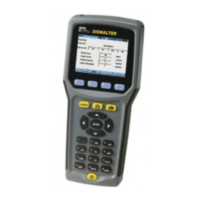Troubleshooting and FAQ’s 7-4
Also, in many instances in-house IT staff may have access to old
installed cabling that they want to use for new applications. A cable
qualifier can quickly determine if the existing cabling is able to
support Gigabit applications.
SIGNALTEK’s active LAN features can also be used to diagnose
cabling or network problems that may not be cable related. The link
establishment, DHCP and ping functions are three of the most
common software tools used to troubleshoot networks. In the event
that a user cannot access the network, the DHCP test can be
quickly run at the user’s workstation to determine if the problem is
in the network or with the user’s computer.
The following steps can be used to troubleshoot a problem work
station:
? Disconnect the patch cord from the PC and connect to
SIGNALTEK. When the link status icon changes to blue, press
the Autotest button.
o A successful Link Establishment, DHCP, and Ping test
indicate that the network is fully functional.
o A failed link establishment test means that the cabling
may be damaged to the point where even a 10Mbps link
could not be negotiated.
o A failed DHCP test indicates that the DHCP server may
not be responding to requests at all or in a timely
manner. Some network viruses have the effect of
slowing down DHCP requests to the point where users
are unable to log onto the network.
o A failed ping test can indicate several problems
depending of the address that the user is attempting to
ping.
Pinging an external (internet) address provides the
best diagnostic information because this verifies
that your internal network is successfully passing

